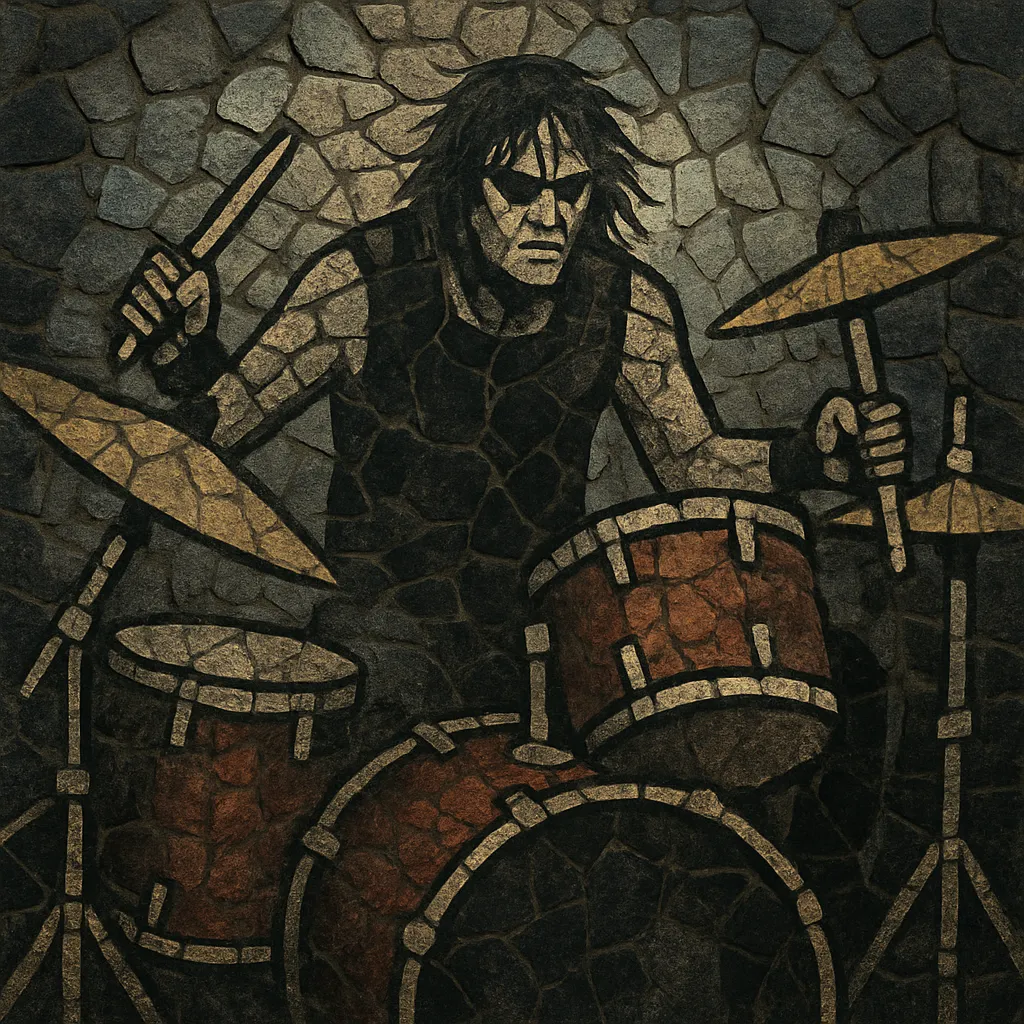
D-beat is a ferociously fast, raw form of punk named after the relentless drum pattern popularized by the UK band Discharge. The style is defined by a charging 4/4 beat with alternating kick and snare on the eighth notes, overdriven guitars playing terse power-chord riffs, and hoarse, shouted vocals.
Lyrically, D-beat is stark, urgent, and political: anti-war, anti-authoritarian, and apocalyptic in tone. Songs are short, direct, and impact-focused—often 1–2 minutes—capturing a feeling of perpetual forward motion. Production tends to be gritty and live, foregrounding intensity over polish.
D-beat emerged in the United Kingdom in the early 1980s, crystallizing around Discharge’s stripped-down, hypercharged approach to punk. Their drum pattern—alternating kick and snare on every eighth note while the hi-hat or ride drives continuous eighths—became the rhythmic signature that defined the style. Rooted in hardcore punk’s speed and anarcho-punk’s political urgency, D-beat also intersected with the UK82 street-punk wave, emphasizing aggression, austerity, and a grim, anti-war worldview.
The sound rapidly spread beyond the UK. In Sweden, bands such as Anti-Cimex helped codify a raw, metallic-tinged variant that would later influence crust scenes. In Japan, groups like Disclose pushed the aesthetic to extremes—maximizing noise, distortion, and monolithic repetition—helping to globalize the D-beat template. Across Europe and the Americas, local scenes adopted the beat, lyrical stance, and minimalist songwriting, creating a transnational network of bands, zines, and DIY venues.
Through the 1990s, D-beat intertwined with crust punk and grind-adjacent hardcore, reinforcing a darker tonality, lower tunings, and heavier guitar textures. UK bands like Doom and The Varukers kept the style visible, while Swedish outfits (Disfear, Wolfbrigade, Skitsystem) refined a dense, chainsaw-like guitar tone. The 2000s brought renewed interest and global proliferation—Japan’s Framtid and others reaffirmed the relentless Discharge-derived formula, while U.S. and European scenes continued to hybridize D-beat with hardcore and metal.
D-beat’s drum feel and uncompromising directness became a lingua franca for extreme punk, informing crust punk’s aesthetics, raw punk’s production values, and the propulsion of early grindcore and powerviolence. Its influence endures wherever political urgency meets maximal impact and minimal ornamentation.
Use a classic punk setup: one or two electric guitars, electric bass, drums, and a vocalist. Tune guitars to standard or down a semitone/whole step for extra heft. Pedals like a ProCo Rat, Boss DS-1, or HM-2-style distortion can deliver the biting, saturated tone common in Swedish-influenced D-beat.
Target 180–220 BPM. The hallmark is the D-beat: keep steady eighth notes on the hi-hat or ride, and alternate kick and snare on each eighth note across the bar. Emphasize a driving, forward-leaning pocket—fills are short and functional (e.g., two-beat snare rolls) to re-launch the groove without breaking momentum.
Compose terse, hook-like power-chord riffs (often built from minor or modal fragments). Favor movement between a few root notes (I–bVII–bVI or similar) and use pedal tones or drones for momentum. Keep parts tightly locked to the drum pattern, with occasional mid-tempo breaks to set up a final acceleration.
Bass follows the guitar rhythm with a pick and slight overdrive to glue the mix. Vocals are shouted or barked, with urgent, syllable-tight phrasing that sits rhythmically on top of the beat. Gang shouts on key refrains amplify impact.
Write concise, slogan-ready lines about war, state violence, social collapse, systemic injustice, and survival. Avoid ornate metaphors; aim for immediacy, repetition, and clarity.
Keep songs short (1–2 minutes). Start with feedback or a single snare pickup, then drop into the D-beat. Track mostly live, limit overdubs, and avoid heavy compression on drums to preserve attack. Prioritize rawness and volume over polish; the mix should feel dense, mid-forward, and relentless.

